Land Cruiser URJ200 URJ202 GRJ200 VDJ200 - HEATING / AIR CONDITIONING
READ VALUE USING INTELLIGENT TESTER (PASSENGER SIDE SOLAR SENSOR)
CHECK HARNESS AND CONNECTOR (AIR CONDITIONING AMPLIFIER - AUTOMATIC LIGHT CONTROL SENSOR)
INSPECT AUTOMATIC LIGHT CONTROL SENSOR (TSR, TSL - CLTE VOLTAGE)
CHECK HARNESS AND CONNECTOR (MAIN BODY ECU - AUTOMATIC LIGHT CONTROL SENSOR)
DTC B14A3 Front Passenger Side Solar Sensor Short Circuit
DESCRIPTION

The automatic light control sensor (solar sensor), which is installed on the upper side of the instrument panel, detects sunlight and controls the air conditioning in auto mode. The output current from the solar sensor varies according to the amount of sunlight. When the sunlight increases, the output current increases. As the sunlight decreases, the output current decreases. The air conditioning amplifier assembly detects output current from the solar sensor.
| DTC Code | DTC Detection Condition | Trouble Area |
| B14A3 | An open or short in the passenger side solar sensor circuit. | Automatic light control sensor (solar sensor) Harness or connector between solar sensor and air conditioning amplifier assembly Harness or connector between solar sensor and main body ECU (cowl side junction block LH) Main body ECU (cowl side junction block LH) Air conditioning amplifier assembly |
- HINT:
- If DTC B1244 is output at the same time, troubleshoot DTC B1244 first.
WIRING DIAGRAM
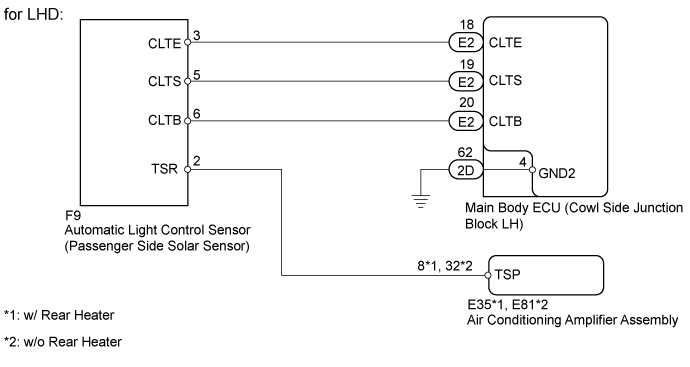
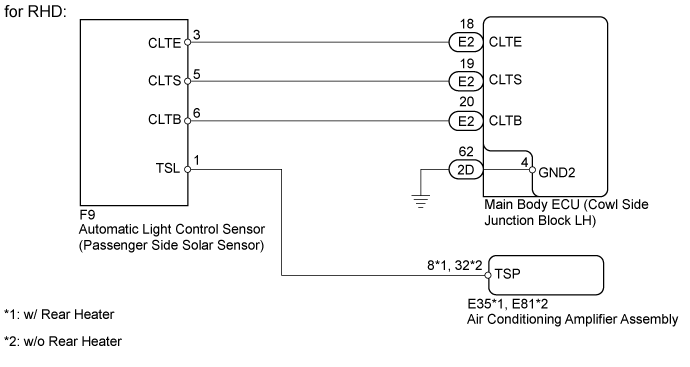
INSPECTION PROCEDURE
| 1.READ VALUE USING INTELLIGENT TESTER (PASSENGER SIDE SOLAR SENSOR) |
Use the Data List to check if the front passenger side solar sensor is functioning properly.
| Tester Display | Measurement Item/Range | Normal Condition | Diagnostic Note |
| Solar Sensor (P Side) | Passenger side solar sensor / Min.: 0, Max.: 255 |
Passenger side solar sensor voltage increases as brightness increases | Open in the circuit: 0. Short in the circuit: 255. |
- OK:
- The display is as specified in the normal condition.
|
| ||||
| OK | ||
| ||
| 2.CHECK HARNESS AND CONNECTOR (AIR CONDITIONING AMPLIFIER - AUTOMATIC LIGHT CONTROL SENSOR) |
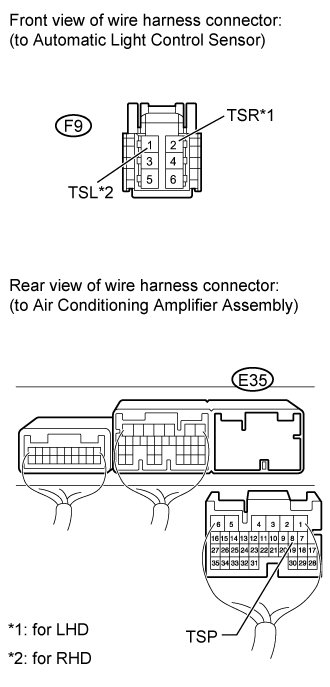
w/ Rear Heater
Disconnect the F9 sensor connector.
Disconnect the E35 amplifier connector.
Measure the resistance according to the value(s) in the table below.
- Standard Resistance:
Tester Connection Condition Specified Condition E35-8 (TSP) - F9-2 (TSR)*1 Always Below 1 Ω E35-8 (TSP) - F9-1 (TSL)*2 Always Below 1 Ω E35-8 (TSP) - Body ground Always 10 kΩ or higher
- HINT:
- *1: for LHD
- *2: for RHD
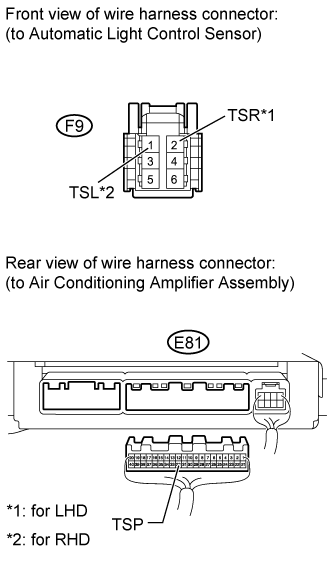
w/o Rear Heater
Disconnect the F9 sensor connector.
Disconnect the E81 amplifier connector.
Measure the resistance according to the value(s) in the table below.
- Standard Resistance:
Tester Connection Condition Specified Condition E81-32 (TSP) - F9-2 (TSR)*1 Always Below 1 Ω E81-32 (TSP) - F9-1 (TSL)*2 Always Below 1 Ω E81-32 (TSP) - Body ground Always 10 kΩ or higher
- HINT:
- *1: for LHD
- *2: for RHD
|
| ||||
| OK | |
| 3.INSPECT AUTOMATIC LIGHT CONTROL SENSOR (TSR, TSL - CLTE VOLTAGE) |
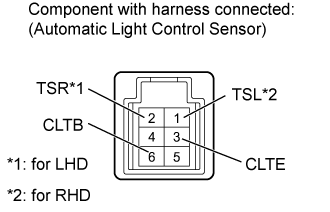
Remove the automatic light control sensor ().
Apply battery voltage between terminals 6 (CLTB) and 3 (CLTE) of the solar sensor.
Measure the voltage according to the value(s) in the table below.
- Standard Voltage:
Tester Connection Condition Specified Condition 2 (TSR) - 3 (CLTE)*1 Sensor exposed to electric light 0.8 to 4.3 V Sensor covered with a cloth Below 0.8 V 1 (TSL) - 3 (CLTE)*2 Sensor exposed to electric light 0.8 to 4.3 V Sensor covered with a cloth Below 0.8 V
- HINT:
|
| ||||
| OK | |
| 4.CHECK HARNESS AND CONNECTOR (MAIN BODY ECU - AUTOMATIC LIGHT CONTROL SENSOR) |

Disconnect the E2 ECU connector.
Disconnect the F9 sensor connector.
Measure the resistance according to the value(s) in the table below.
- Standard Resistance:
Tester Connection Condition Specified Condition E2-20 (CLTB) - F9-6 (CLTB) Always Below 1 Ω E2-19 (CLTS) - F9-5 (CLTS) E2-18 (CLTE) - F9-3 (CLTE) E2-20 (CLTB) - Body ground Always 10 kΩ or higher E2-19 (CLTS) - Body ground E2-18 (CLTE) - Body ground
|
| ||||
| OK | ||
| ||